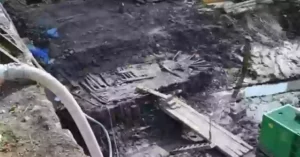
Next week marks the 23rd anniversary of the tragic 9/11 attacks, a day that changed the world forever. The aftermath left the nation in mourning, reshaped air travel, and triggered a massive overhaul of security protocols with an intensified focus on terrorism.
However, amidst the destruction of the World Trade Center, an unexpected discovery emerged years later that would leave everyone puzzled. In 2010, while workers were clearing the site to begin rebuilding, they uncovered the remnants of an ancient wooden ship buried deep in the rubble.
This mysterious find baffled experts and sparked widespread curiosity. How did a centuries-old vessel end up buried 22 feet beneath the Twin Towers? The ship’s discovery set off a long investigation, with archaeologists and historians working for over four years to unravel its origins.
The ship, they determined, was built in the 1770s—around the same time as the signing of the Declaration of Independence. The construction of the ship was traced to Philadelphia, with the type of oak used for its hull matching the wood used to build Independence Hall. The wooden rings in the ship’s hull were even found to align with those used in the construction of that historic building.
It turned out the ship was a Hudson River sloop, a type of vessel designed by the Dutch in the 17th century to navigate the rocky floors of the Hudson River and carry both cargo and passengers. But how did it end up buried so far from its natural habitat?
Researchers believe that after serving for 20 to 30 years, the ship was brought to Lower Manhattan, where it eventually sank. Whether it was an accident or a deliberate scuttling remains unclear.
As the years passed, the ship’s remains were buried under layers of debris, refuse, and landfill material used to expand Manhattan. The hull was even found to be covered in oysters, indicating it had been submerged for quite some time before being entombed beneath the trash that would later become the foundation of the Twin Towers.
In a 2014 interview with CNN, archaeologist Molly McDonald, one of the team members who uncovered the ship, described the experience: “It’s such an intense site already based on its recent history, so to be in the midst of this urban, modern, very fraught location, and then to be sitting on what was a river bottom, with clams and fish, and the smell of low tide, was really an amazing juxtaposition.”
Today, the remnants of the ship are being carefully preserved and displayed at the New York State Museum in Albany, offering visitors a chance to explore this fascinating, if eerie, piece of history.





